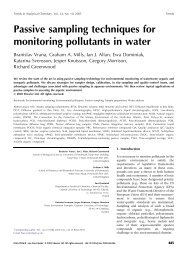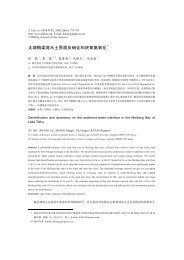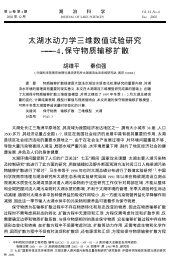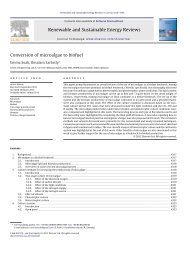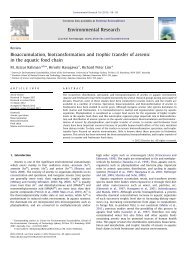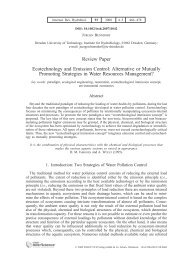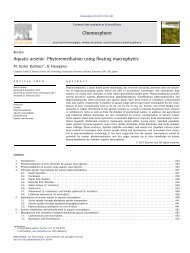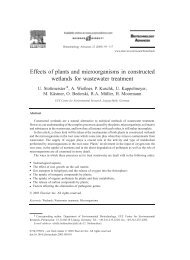- Page 2:
This page intentionally left blank
- Page 6:
ecology, biodiversity, and conserva
- Page 10:
cambridge university press Cambridg
- Page 16:
Contents Preface Acknowledgements p
- Page 20:
References Index to lakes, rivers a
- Page 26:
xii PREFACE questions the very conc
- Page 30:
Acknowledgements Except where state
- Page 34:
2 PHYTOPLANKTON In this way, plankt
- Page 38:
4 PHYTOPLANKTON ecosystems, Hensen
- Page 42:
6 PHYTOPLANKTON Table 1.1 Survey of
- Page 46:
8 PHYTOPLANKTON Table 1.1 (cont.) P
- Page 50:
10 PHYTOPLANKTON Table 1.1 (cont.)
- Page 54:
12 PHYTOPLANKTON of producing popul
- Page 58:
14 PHYTOPLANKTON The relatively rec
- Page 62:
16 PHYTOPLANKTON reveals a commensu
- Page 66:
18 PHYTOPLANKTON mechanisms for inc
- Page 70:
20 PHYTOPLANKTON Table 1.2 Nominal
- Page 74:
22 PHYTOPLANKTON Notes to Table 1.2
- Page 78:
24 PHYTOPLANKTON attenuated cells (
- Page 82:
26 PHYTOPLANKTON Table 1.3 Air-dry
- Page 86:
28 PHYTOPLANKTON Volcani, 1981). In
- Page 90:
30 PHYTOPLANKTON Figure 1.9 The sil
- Page 94:
32 PHYTOPLANKTON Analogous argument
- Page 98:
34 PHYTOPLANKTON Cell chlorophyll a
- Page 102:
36 PHYTOPLANKTON Figure 1.11 Log/lo
- Page 106:
Chapter 2 Entrainment and distribut
- Page 110:
40 ENTRAINMENT AND DISTRIBUTION IN
- Page 114:
42 ENTRAINMENT AND DISTRIBUTION IN
- Page 118:
44 ENTRAINMENT AND DISTRIBUTION IN
- Page 122:
46 ENTRAINMENT AND DISTRIBUTION IN
- Page 126:
48 ENTRAINMENT AND DISTRIBUTION IN
- Page 130:
50 ENTRAINMENT AND DISTRIBUTION IN
- Page 134:
52 ENTRAINMENT AND DISTRIBUTION IN
- Page 138:
54 ENTRAINMENT AND DISTRIBUTION IN
- Page 142:
56 ENTRAINMENT AND DISTRIBUTION IN
- Page 146:
58 ENTRAINMENT AND DISTRIBUTION IN
- Page 150:
60 ENTRAINMENT AND DISTRIBUTION IN
- Page 154:
62 ENTRAINMENT AND DISTRIBUTION IN
- Page 158:
64 ENTRAINMENT AND DISTRIBUTION IN
- Page 162:
66 ENTRAINMENT AND DISTRIBUTION IN
- Page 166:
68 ENTRAINMENT AND DISTRIBUTION IN
- Page 170:
70 ENTRAINMENT AND DISTRIBUTION IN
- Page 174:
72 ENTRAINMENT AND DISTRIBUTION IN
- Page 178:
74 ENTRAINMENT AND DISTRIBUTION IN
- Page 182:
76 ENTRAINMENT AND DISTRIBUTION IN
- Page 186:
78 ENTRAINMENT AND DISTRIBUTION IN
- Page 190:
80 ENTRAINMENT AND DISTRIBUTION IN
- Page 194:
82 ENTRAINMENT AND DISTRIBUTION IN
- Page 198:
84 ENTRAINMENT AND DISTRIBUTION IN
- Page 202:
86 ENTRAINMENT AND DISTRIBUTION IN
- Page 206:
88 ENTRAINMENT AND DISTRIBUTION IN
- Page 210:
90 ENTRAINMENT AND DISTRIBUTION IN
- Page 214:
92 ENTRAINMENT AND DISTRIBUTION IN
- Page 218:
94 PHOTOSYNTHESIS AND CARBON ACQUIS
- Page 222:
96 PHOTOSYNTHESIS AND CARBON ACQUIS
- Page 226:
98 PHOTOSYNTHESIS AND CARBON ACQUIS
- Page 230:
100 PHOTOSYNTHESIS AND CARBON ACQUI
- Page 234:
102 PHOTOSYNTHESIS AND CARBON ACQUI
- Page 238:
104 PHOTOSYNTHESIS AND CARBON ACQUI
- Page 242:
106 PHOTOSYNTHESIS AND CARBON ACQUI
- Page 246:
108 PHOTOSYNTHESIS AND CARBON ACQUI
- Page 250:
110 PHOTOSYNTHESIS AND CARBON ACQUI
- Page 254:
112 PHOTOSYNTHESIS AND CARBON ACQUI
- Page 258:
114 PHOTOSYNTHESIS AND CARBON ACQUI
- Page 262:
116 PHOTOSYNTHESIS AND CARBON ACQUI
- Page 266:
118 PHOTOSYNTHESIS AND CARBON ACQUI
- Page 270:
120 PHOTOSYNTHESIS AND CARBON ACQUI
- Page 274:
122 PHOTOSYNTHESIS AND CARBON ACQUI
- Page 278:
124 PHOTOSYNTHESIS AND CARBON ACQUI
- Page 282:
126 PHOTOSYNTHESIS AND CARBON ACQUI
- Page 286:
128 PHOTOSYNTHESIS AND CARBON ACQUI
- Page 290:
130 PHOTOSYNTHESIS AND CARBON ACQUI
- Page 294:
132 PHOTOSYNTHESIS AND CARBON ACQUI
- Page 298:
134 PHOTOSYNTHESIS AND CARBON ACQUI
- Page 302:
136 PHOTOSYNTHESIS AND CARBON ACQUI
- Page 306:
138 PHOTOSYNTHESIS AND CARBON ACQUI
- Page 310:
140 PHOTOSYNTHESIS AND CARBON ACQUI
- Page 314:
142 PHOTOSYNTHESIS AND CARBON ACQUI
- Page 318:
144 PHOTOSYNTHESIS AND CARBON ACQUI
- Page 322:
146 NUTRIENT UPTAKE AND ASSIMILATIO
- Page 326:
148 NUTRIENT UPTAKE AND ASSIMILATIO
- Page 330:
150 NUTRIENT UPTAKE AND ASSIMILATIO
- Page 334:
152 NUTRIENT UPTAKE AND ASSIMILATIO
- Page 338:
154 NUTRIENT UPTAKE AND ASSIMILATIO
- Page 342:
156 NUTRIENT UPTAKE AND ASSIMILATIO
- Page 346:
158 NUTRIENT UPTAKE AND ASSIMILATIO
- Page 350:
160 NUTRIENT UPTAKE AND ASSIMILATIO
- Page 354:
162 NUTRIENT UPTAKE AND ASSIMILATIO
- Page 358:
164 NUTRIENT UPTAKE AND ASSIMILATIO
- Page 362:
166 NUTRIENT UPTAKE AND ASSIMILATIO
- Page 366:
168 NUTRIENT UPTAKE AND ASSIMILATIO
- Page 370:
170 NUTRIENT UPTAKE AND ASSIMILATIO
- Page 374:
172 NUTRIENT UPTAKE AND ASSIMILATIO
- Page 378:
174 NUTRIENT UPTAKE AND ASSIMILATIO
- Page 382:
176 NUTRIENT UPTAKE AND ASSIMILATIO
- Page 386:
Chapter 5 Growth and replication of
- Page 390:
180 GROWTH AND REPLICATION OF PHYTO
- Page 394:
182 GROWTH AND REPLICATION OF PHYTO
- Page 398:
184 GROWTH AND REPLICATION OF PHYTO
- Page 402:
186 GROWTH AND REPLICATION OF PHYTO
- Page 406:
188 GROWTH AND REPLICATION OF PHYTO
- Page 410:
190 GROWTH AND REPLICATION OF PHYTO
- Page 414:
192 GROWTH AND REPLICATION OF PHYTO
- Page 418:
194 GROWTH AND REPLICATION OF PHYTO
- Page 422:
196 GROWTH AND REPLICATION OF PHYTO
- Page 426:
198 GROWTH AND REPLICATION OF PHYTO
- Page 430:
200 GROWTH AND REPLICATION OF PHYTO
- Page 434:
202 GROWTH AND REPLICATION OF PHYTO
- Page 438:
204 GROWTH AND REPLICATION OF PHYTO
- Page 442:
206 GROWTH AND REPLICATION OF PHYTO
- Page 446:
208 GROWTH AND REPLICATION OF PHYTO
- Page 450:
210 GROWTH AND REPLICATION OF PHYTO
- Page 454:
212 GROWTH AND REPLICATION OF PHYTO
- Page 458:
214 GROWTH AND REPLICATION OF PHYTO
- Page 462:
216 GROWTH AND REPLICATION OF PHYTO
- Page 466:
218 GROWTH AND REPLICATION OF PHYTO
- Page 470:
220 GROWTH AND REPLICATION OF PHYTO
- Page 474:
222 GROWTH AND REPLICATION OF PHYTO
- Page 478:
224 GROWTH AND REPLICATION OF PHYTO
- Page 482:
226 GROWTH AND REPLICATION OF PHYTO
- Page 486:
228 GROWTH AND REPLICATION OF PHYTO
- Page 490:
230 GROWTH AND REPLICATION OF PHYTO
- Page 494:
232 GROWTH AND REPLICATION OF PHYTO
- Page 498:
234 GROWTH AND REPLICATION OF PHYTO
- Page 502:
236 GROWTH AND REPLICATION OF PHYTO
- Page 506:
238 GROWTH AND REPLICATION OF PHYTO
- Page 510:
240 MORTALITY AND LOSS PROCESSES IN
- Page 514:
242 MORTALITY AND LOSS PROCESSES IN
- Page 518:
244 MORTALITY AND LOSS PROCESSES IN
- Page 522:
246 MORTALITY AND LOSS PROCESSES IN
- Page 526:
248 MORTALITY AND LOSS PROCESSES IN
- Page 530:
250 MORTALITY AND LOSS PROCESSES IN
- Page 534:
252 MORTALITY AND LOSS PROCESSES IN
- Page 538:
254 MORTALITY AND LOSS PROCESSES IN
- Page 542:
256 MORTALITY AND LOSS PROCESSES IN
- Page 546:
258 MORTALITY AND LOSS PROCESSES IN
- Page 550:
260 MORTALITY AND LOSS PROCESSES IN
- Page 554:
262 MORTALITY AND LOSS PROCESSES IN
- Page 558:
264 MORTALITY AND LOSS PROCESSES IN
- Page 562:
266 MORTALITY AND LOSS PROCESSES IN
- Page 566:
268 MORTALITY AND LOSS PROCESSES IN
- Page 570:
270 MORTALITY AND LOSS PROCESSES IN
- Page 574:
272 MORTALITY AND LOSS PROCESSES IN
- Page 578:
274 MORTALITY AND LOSS PROCESSES IN
- Page 582:
276 MORTALITY AND LOSS PROCESSES IN
- Page 586:
278 MORTALITY AND LOSS PROCESSES IN
- Page 590:
280 MORTALITY AND LOSS PROCESSES IN
- Page 594:
282 MORTALITY AND LOSS PROCESSES IN
- Page 598:
284 MORTALITY AND LOSS PROCESSES IN
- Page 602:
286 MORTALITY AND LOSS PROCESSES IN
- Page 606:
288 MORTALITY AND LOSS PROCESSES IN
- Page 610:
290 MORTALITY AND LOSS PROCESSES IN
- Page 614:
292 MORTALITY AND LOSS PROCESSES IN
- Page 618:
294 MORTALITY AND LOSS PROCESSES IN
- Page 622:
296 MORTALITY AND LOSS PROCESSES IN
- Page 626:
298 MORTALITY AND LOSS PROCESSES IN
- Page 630:
300 MORTALITY AND LOSS PROCESSES IN
- Page 634:
Chapter 7 Community assembly in the
- Page 638:
304 COMMUNITY ASSEMBLY IN THE PLANK
- Page 642:
306 COMMUNITY ASSEMBLY IN THE PLANK
- Page 646:
308 COMMUNITY ASSEMBLY IN THE PLANK
- Page 650:
310 COMMUNITY ASSEMBLY IN THE PLANK
- Page 654:
312 COMMUNITY ASSEMBLY IN THE PLANK
- Page 658:
314 COMMUNITY ASSEMBLY IN THE PLANK
- Page 662:
316 COMMUNITY ASSEMBLY IN THE PLANK
- Page 666:
318 COMMUNITY ASSEMBLY IN THE PLANK
- Page 670:
320 COMMUNITY ASSEMBLY IN THE PLANK
- Page 674:
322 COMMUNITY ASSEMBLY IN THE PLANK
- Page 678:
324 COMMUNITY ASSEMBLY IN THE PLANK
- Page 682:
326 COMMUNITY ASSEMBLY IN THE PLANK
- Page 686:
328 COMMUNITY ASSEMBLY IN THE PLANK
- Page 690:
330 COMMUNITY ASSEMBLY IN THE PLANK
- Page 694:
332 COMMUNITY ASSEMBLY IN THE PLANK
- Page 698:
334 COMMUNITY ASSEMBLY IN THE PLANK
- Page 702:
336 COMMUNITY ASSEMBLY IN THE PLANK
- Page 706:
338 COMMUNITY ASSEMBLY IN THE PLANK
- Page 710:
340 COMMUNITY ASSEMBLY IN THE PLANK
- Page 714:
342 COMMUNITY ASSEMBLY IN THE PLANK
- Page 718:
344 COMMUNITY ASSEMBLY IN THE PLANK
- Page 722:
346 COMMUNITY ASSEMBLY IN THE PLANK
- Page 726:
348 COMMUNITY ASSEMBLY IN THE PLANK
- Page 730:
350 COMMUNITY ASSEMBLY IN THE PLANK
- Page 734:
352 COMMUNITY ASSEMBLY IN THE PLANK
- Page 738:
354 COMMUNITY ASSEMBLY IN THE PLANK
- Page 742:
356 COMMUNITY ASSEMBLY IN THE PLANK
- Page 746:
358 COMMUNITY ASSEMBLY IN THE PLANK
- Page 750:
360 COMMUNITY ASSEMBLY IN THE PLANK
- Page 754:
362 COMMUNITY ASSEMBLY IN THE PLANK
- Page 758:
364 COMMUNITY ASSEMBLY IN THE PLANK
- Page 762:
366 COMMUNITY ASSEMBLY IN THE PLANK
- Page 766:
368 COMMUNITY ASSEMBLY IN THE PLANK
- Page 770:
370 COMMUNITY ASSEMBLY IN THE PLANK
- Page 774:
372 COMMUNITY ASSEMBLY IN THE PLANK
- Page 778:
374 COMMUNITY ASSEMBLY IN THE PLANK
- Page 782:
376 COMMUNITY ASSEMBLY IN THE PLANK
- Page 786:
378 COMMUNITY ASSEMBLY IN THE PLANK
- Page 790:
380 COMMUNITY ASSEMBLY IN THE PLANK
- Page 794:
382 COMMUNITY ASSEMBLY IN THE PLANK
- Page 798:
384 COMMUNITY ASSEMBLY IN THE PLANK
- Page 802:
386 COMMUNITY ASSEMBLY IN THE PLANK
- Page 806:
388 PHYTOPLANKTON ECOLOGY AND AQUAT
- Page 810:
390 PHYTOPLANKTON ECOLOGY AND AQUAT
- Page 814:
392 PHYTOPLANKTON ECOLOGY AND AQUAT
- Page 818:
394 PHYTOPLANKTON ECOLOGY AND AQUAT
- Page 822:
396 PHYTOPLANKTON ECOLOGY AND AQUAT
- Page 826:
398 PHYTOPLANKTON ECOLOGY AND AQUAT
- Page 830:
400 PHYTOPLANKTON ECOLOGY AND AQUAT
- Page 834:
402 PHYTOPLANKTON ECOLOGY AND AQUAT
- Page 838:
404 PHYTOPLANKTON ECOLOGY AND AQUAT
- Page 842:
406 PHYTOPLANKTON ECOLOGY AND AQUAT
- Page 846:
408 PHYTOPLANKTON ECOLOGY AND AQUAT
- Page 850:
410 PHYTOPLANKTON ECOLOGY AND AQUAT
- Page 854:
412 PHYTOPLANKTON ECOLOGY AND AQUAT
- Page 858:
414 PHYTOPLANKTON ECOLOGY AND AQUAT
- Page 862:
416 PHYTOPLANKTON ECOLOGY AND AQUAT
- Page 866: 418 PHYTOPLANKTON ECOLOGY AND AQUAT
- Page 870: 420 PHYTOPLANKTON ECOLOGY AND AQUAT
- Page 874: 422 PHYTOPLANKTON ECOLOGY AND AQUAT
- Page 878: 424 PHYTOPLANKTON ECOLOGY AND AQUAT
- Page 882: 426 PHYTOPLANKTON ECOLOGY AND AQUAT
- Page 886: 428 PHYTOPLANKTON ECOLOGY AND AQUAT
- Page 890: 430 PHYTOPLANKTON ECOLOGY AND AQUAT
- Page 894: 432 PHYTOPLANKTON ECOLOGY AND AQUAT
- Page 898: 434 PHYTOPLANKTON ECOLOGY AND AQUAT
- Page 902: 436 PHYTOPLANKTON ECOLOGY AND AQUAT
- Page 906: 438 GLOSSARY form resistance the re
- Page 910: Units, symbols and abbreviations UN
- Page 914: 442 UNITS, SYMBOLS AND ABBREVIATION
- Page 920: z(0.5I k) depth beneath the water s
- Page 924: References Abeliovich, A. and Shilo
- Page 928: Productivity, ed. P. J. leB. Willia
- Page 932: Bowen, C. C. and Jensen, T. E. (196
- Page 936: (1980). Some general observations o
- Page 940: shallow lake, with special referenc
- Page 944: Sensing, ed.F.M. Danson and S. E. P
- Page 948: Algal Blooms, ed.D. M. Anderson, A.
- Page 952: (2002). Global dispersal of free-li
- Page 956: (2002). Regional scale influences o
- Page 960: northern pike, aquatic vegetation a
- Page 964: Heaney, S. I., Canter, H. M. and Lu
- Page 968:
Huisman, J. and Sommeijer, B. (2002
- Page 972:
on growth and sinking rate of two p
- Page 976:
Kierstead, H. and Slobodkin, L. B.
- Page 980:
y various predators. Microbial Ecol
- Page 984:
Levich, A. P. (1996). The role of n
- Page 988:
Lund, J. W. G., Kipling, C. and Le
- Page 992:
(1987). Trophic dynamics and develo
- Page 996:
organisms in a hypereutrophic pond.
- Page 1000:
Owens, O. van H. and Esaias, W. (19
- Page 1004:
(1999). Spatial structure of pelagi
- Page 1008:
composition of plankton. In The Jam
- Page 1012:
(2000a). Phytoplankton designer or
- Page 1016:
Richey, J. E., Melack, J. M. Aufdem
- Page 1020:
Sarmiento, J. L. and Wofsy, S. C. (
- Page 1024:
Sirenko, L. A., Stetsenko, N. M., A
- Page 1028:
Spencer, M. and Warren, P. H. (1996
- Page 1032:
(1957a). Diurnal changes of stratif
- Page 1036:
growth rate of Microcystis (Cyanoba
- Page 1040:
Walsby, A. E., Utkilen, H. C. and J
- Page 1044:
Microcystis aeruginosa hyperscums f
- Page 1048:
Lowes Water, UK 54 ◦ 34 ′ N, 3
- Page 1052:
Index to genera and species of phyt
- Page 1056:
Chromulina (Chrysophyta CHROMULINAL
- Page 1060:
Glaucocystis (Glaucophyta) F6 Table
- Page 1064:
Peridinium gatunense Nygaard F, LO
- Page 1068:
Synedra ulna (Nitzsch) Ehrenb. F, B
- Page 1072:
Daphnia galeata 221, 261, 266, 266
- Page 1076:
Tropocyclops Crustacea, Cyclopoidea
- Page 1080:
own tides, 407 bryophytes, 11 bryoz
- Page 1084:
‘swimming’ velocities, 68; vita
- Page 1088:
keystone species, 382, 394, 427 kin
- Page 1092:
particulate organic matter (POM), 3
- Page 1096:
quantum yield of photosynthesis, 98
- Page 1100:
vertical migration of phytoplankton



